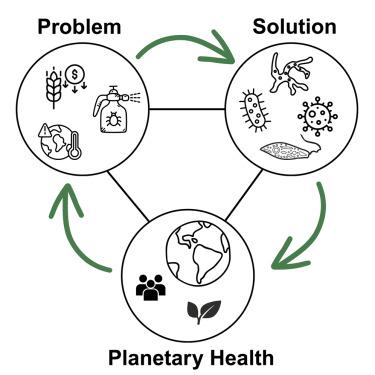维持地球健康的微生物植物保护应用的益处和挑战
IF 4.1
2区 综合性期刊
Q1 MULTIDISCIPLINARY SCIENCES
引用次数: 0
摘要
植物病害暴发对全球粮食安全构成严重威胁。由于气候变化,预计会出现新的疾病,目前化学农药的使用对环境和人类健康构成风险。近十年来,微生物源植物保护替代剂的开发也引起了业界的极大期待。目前的产品主要代表单个微生物菌株,无论是真菌还是细菌,由于各种因素,它们偶尔会在野外条件下失效,而它们的监管地位在全球范围内是不同的。最近,更多样化的应用已经开始出现,从微生物联合体,噬菌体和原生生物到微生物组调节或土壤转运。还提出了结合人工智能的综合解决方案。在这篇综述中,我们讨论了这些解决方案的机遇和挑战,提供了具体的例子,并讨论了它们进入市场的监管需求以及它们与改善粮食安全和地球健康的相关性。本文章由计算机程序翻译,如有差异,请以英文原文为准。

Benefits and challenges of upcoming microbial plant protection applications sustaining planetary health
Plant disease outbreaks pose severe risks to global food security. Due to climate change, new diseases are expected to emerge, and the current use of chemical pesticides poses risks to environmental and human health. In the last decade, alternative plant protection agents of microbial origin have been developed, which also raise great expectations in the industry. Current products primarily represent individual microbial strains, either fungi or bacteria, which occasionally fail under field conditions due to various factors while their regulatory status differs globally. Recently, more diverse applications have started to emerge, ranging from microbial consortia, phages and protists to microbiome modulation or soil translocation. Integrated solutions, incorporating artificial intelligence are also proposed. In this review, we discuss the opportunities and challenges of these solutions, providing specific examples and discuss the regulatory needs for their market entry as well as their relevance for improving food security and planetary health.
求助全文
通过发布文献求助,成功后即可免费获取论文全文。
去求助
来源期刊

iScience
Multidisciplinary-Multidisciplinary
CiteScore
7.20
自引率
1.70%
发文量
1972
审稿时长
6 weeks
期刊介绍:
Science has many big remaining questions. To address them, we will need to work collaboratively and across disciplines. The goal of iScience is to help fuel that type of interdisciplinary thinking. iScience is a new open-access journal from Cell Press that provides a platform for original research in the life, physical, and earth sciences. The primary criterion for publication in iScience is a significant contribution to a relevant field combined with robust results and underlying methodology. The advances appearing in iScience include both fundamental and applied investigations across this interdisciplinary range of topic areas. To support transparency in scientific investigation, we are happy to consider replication studies and papers that describe negative results.
We know you want your work to be published quickly and to be widely visible within your community and beyond. With the strong international reputation of Cell Press behind it, publication in iScience will help your work garner the attention and recognition it merits. Like all Cell Press journals, iScience prioritizes rapid publication. Our editorial team pays special attention to high-quality author service and to efficient, clear-cut decisions based on the information available within the manuscript. iScience taps into the expertise across Cell Press journals and selected partners to inform our editorial decisions and help publish your science in a timely and seamless way.
 求助内容:
求助内容: 应助结果提醒方式:
应助结果提醒方式:


